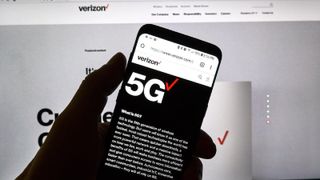5G weekly efficiency updates are expected in the beginning, says Verizon
Faster updates, better tech

By the end of 2019, Verizon 5G had launched service in 31 cities across the US. As the network expands in 2020, more customers will experience the promised 1Gbps speeds - but there are other benefits to 5G.
In a meeting room deep in the Sands Convention Center at CES 2020, Verizon consumer wireless group CEO Ronan Dunne explained to TechRadar how the network’s properties will allow the carrier to upgrade it far more often than its 4G network.
“In an LTE world, you were having two drops of software per annum,” Dunne said. “In the 5G network, we’re seeing software drops on a weekly basis. We’re seeing new functionality, new capabilities, new enhancements to the efficiency of the radius and the spectrum. So the curve of innovation post-deployment is actually much much faster than it was in the 4G world.”
- Phones, computers, TVs, robots: here's all the great tech we saw at CES 2020
- There are plenty of 5G phones on sale right now - but which are the best?
- Verizon isn't the only 5G game in town - all we know about T-Mobile 5G's plans
- See all the best cell phone plans available right now
In short: Verizon’s 5G network will improve at a faster rate than 4G, at least in terms of software. But that could make it more nimble, adapting to new technologies or strategies.
Verizon will, of course, continue to build out its infrastructure. The carrier’s 5G network reached 31 cities by the end of 2019, though Dunne wouldn’t say how many the company is planning to expand to in 2020.
It’s not just city-by-city expansion, either: while Verizon 5G was initially built on top of the carrier’s existing 4G network, the next step is to build out its own fully virtualized 5G network core. In essence: lower-priority data like authentication will be on the 4G network, while the upcoming 5G core will be dedicated to big-data exchanges.
Speedy software updates won’t just be limited to mobile 5G, either - because Verizon’s also improving its 5G Home in 2020, too.
Get daily insight, inspiration and deals in your inbox
Get the hottest deals available in your inbox plus news, reviews, opinion, analysis and more from the TechRadar team.

5G out there - and in the home
While Verizon has been touting 5G Home - essentially using cell towers to beam 5G to customers’ homes as an alternative to wired home internet - the company hasn’t said much about it’s wider availability beyond currently offering it in select cities, including Indianapolis, Los Angeles, Sacramento, Houston, and now Chicago.
In our chat, Dunne confirmed that the Qualcomm CPE chip at the heart of 5G Home has been delayed, but they expect to see it arrive by the middle of 2020. Once that happens, Verizon will have an extra push for 5G Home in the second half of the year.
We saw Verizon 5G Home at a demonstration for its launch in Chicago and, while the speeds we saw of 147.2 Mbps speeds were nominally better than typical home internet, we came away with questions about its capability in real-world deployments. Would trees or other signal occlusions between tower and customer homes limit those speeds? Or would the signal decline over distance from the signal emitter?
5G Home has a lot of potential for its simplified installation (no more laying cable) and its potential for more streamlined improvements (over-the-air upgrades instead of replacing old cable with better new lines). Until we see it perform in real-world conditions, we’ll be excited about its possibilities but wary of complications.
David is now a mobile reporter at Cnet. Formerly Mobile Editor, US for TechRadar, he covered phones, tablets, and wearables. He still thinks the iPhone 4 is the best-looking smartphone ever made. He's most interested in technology, gaming and culture – and where they overlap and change our lives. His current beat explores how our on-the-go existence is affected by new gadgets, carrier coverage expansions, and corporate strategy shifts.

